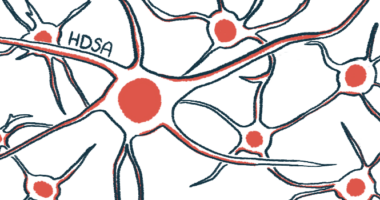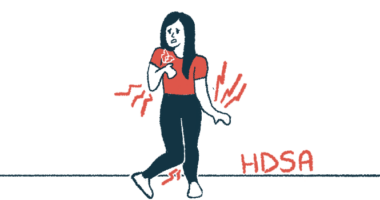VY-HTT01 for Huntington’s disease
Last updated July 30, 2024, by Marisa Wexler, MS

What is VY-HTT01 for Huntington’s disease?
VY-HTT01 is an experimental gene therapy that Voyager Therapeutics had been developing to slow or halt Huntington’s disease progression. Sanofi-Genzyme and the U.S.-based CHDI Foundation also were involved in the therapy’s development at some point.
Meant to be administered directly into the brain through a surgical procedure, the therapy was set to be tested in early-stage Huntington’s patients as part of a first-in-human trial.
However, before that study was launched, Voyager announced in 2021 that it was discontinuing VY-HTT01’s development to focus on other potential gene therapies, including for Huntington’s, that would allow intravenous, or into-the-vein, administration, a less invasive delivery route.
Therapy snapshot
| Treatment name: | VY-HTT01 |
| Administration: | Meant to be given directly into the brain via surgery |
| Clinical testing: | Development discontinued before testing in trials |
How does VY-HTT01 work in Huntington’s disease?
Huntington’s is a neurodegenerative disease caused by mutations in the huntingtin (HTT) gene. The mutation results in the production of an abnormally long HTT protein that is prone to forming toxic clumps that accumulate inside nerve cells, causing their death.
This neurodegeneration leads to symptoms that include a progressive decline in thinking and movement ability, as well as behavioral changes and psychiatric disturbances.
VY-HTT01 is a type of gene silencing therapy aimed at addressing the underlying cause of Huntington’s by significantly reducing the amount of mutant HTT protein produced.
Based on RNA interference (RNAi) technology, the therapy was designed to deliver to cells small pieces of genetic material, called microRNAs, that target specific messenger RNAs (mRNAs). Those intermediary molecules are derived from DNA that guide protein production.
VY-HTT01’s microRNAs bind specifically to both normal and mutated HTT’s mRNA molecules, promoting their destruction and preventing further production of HTT protein. As such, the therapy was expected to reduce levels of the mutant HTT protein, which drives the disease.
The RNAi therapy used a modified and harmless adeno-associated virus to deliver the microRNA into brain cells. To target mostly brain nerve cells, VY-HTT01 was designed to be administered directly into the putamen and thalamus, two deep brain regions affected by Huntington’s.
In preclinical studies, the therapy was shown to reduce brain levels of toxic HTT protein and ease symptoms in a Huntington’s mouse model. It also worked to lower HTT’s mRNA levels in deep brain tissues in non-human primates.
How was VY-HTT01 administered in Huntington’s disease?
VY-HTT01 was never administered to people. In a planned clinical trial, a single dose of the therapy would have been injected, via a surgical procedure, directly into the putamen and thalamus on either one side of the brain or both.
VY-HTT01 in Huntington’s disease clinical trials
A Phase 1b trial, called VYTAL (NCT04885114), was designed to evaluate the safety, tolerability, and biological effects of three doses of VY-HTT01 in adults with early-stage Huntington’s.
Participants had been expected to receive a single MRI-guided infusion of the therapy. Patients assigned to the lower dose would receive the therapy either only on one side of the brain or on both sides. The medium and high doses would have been given on both sides of the brain.
Safety measures, changes in blood levels of the therapy, HTT protein, and a marker of nerve cell damage were meant to be assessed for one year after dosing. The study also was supposed to assess any change in disability, cognitive function, and life-qualify measures.
However, the development of VY-HTT01 was discontinued before any patients were recruited into the trial.
Common side effects of VY-HTT01
VY-HTT01 was never tested in people, so its safety profile is unknown. In nonhuman primates, the therapy was not reported to cause noteworthy toxicity.
Huntington’s Disease News is strictly a news and information website about the disease. It does not provide medical advice, diagnosis or treatment. This content is not intended to be a substitute for professional medical advice, diagnosis, or treatment. Always seek the advice of your physician or other qualified health provider with any questions you may have regarding a medical condition. Never disregard professional medical advice or delay in seeking it because of something you have read on this website.
Recent Posts
- What I want medical students to know about Huntington’s and bias
- Ingrezza treatment eases disease burden due to Huntington’s chorea
- A murder trial opened my eyes about Huntington’s and face reading
- What I want people to stop saying about Huntington’s disease
- HDSA 2025: Dance classes may improve balance in Huntington’s
- HDSA 2025: Long-term care transition requires communication
- Guest Voice: Huntington’s disease is rare, but love isn’t
- HDSA 2025: Observational studies in Huntington’s now enrolling in US
- HDSA 2025: Speakers spotlight Huntington’s clinical trials
- HDSA 2025: Speech therapy can help Huntington’s disease patients
Related articles





